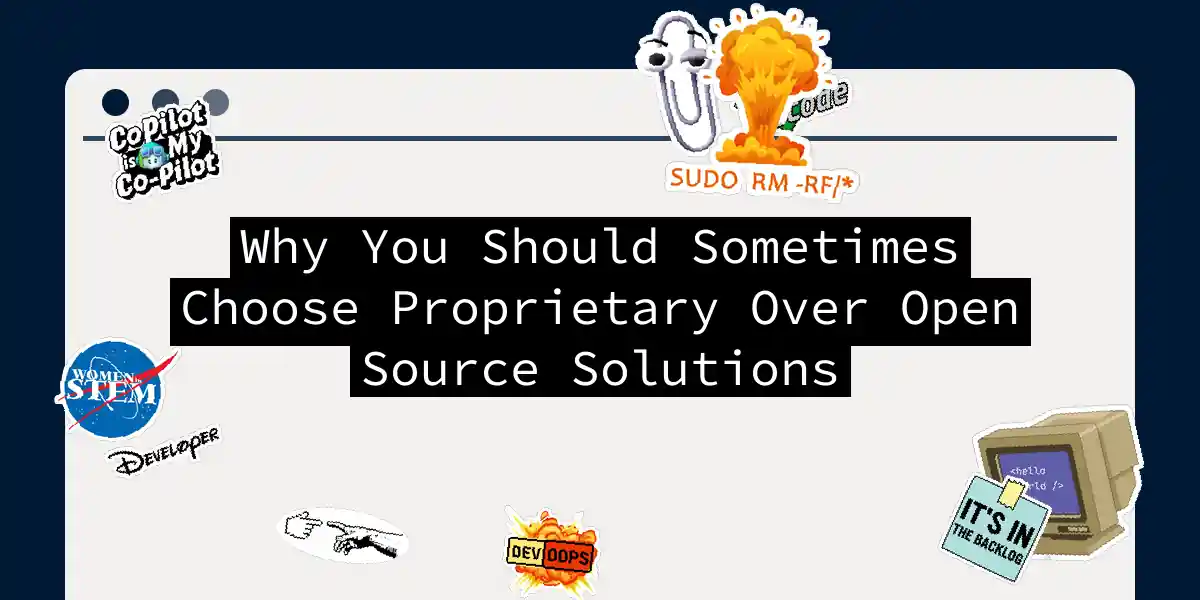Proprietary software - the Judas goat of the open-source revolution. Yet, there are moments when doubling down on vendor lock-in might save your neck. Let’s navigate this sacred cow massacre together.
When the Vendor’s Iron Fist is Your Best Friend
Enterprise SLAs: “Call this number, get someone who knows what they’re talking about”
Need 24/7 support with someone who won’t tell you to “check the logs”? Proprietary solutions often come with premium support packages where you’re not the sole maintainer. Those same vendors who hold your IP hostage? They’re also the ones who’ll ship a security patch faster than Linus can mutter “C++ sucks”.
No-Code Nirvana: “I don’t code, I model… business processes”
Tools like Adobe Experience Manager or Sitecore aren’t made for developers. They’re engineered for marketing teams to drag-and-drop their way to a respectable website. The beauty? No dependency on your team maintaining a custom CMS - just hand the keys to the content creators and watch the magic happen.
Deadline: “I’ll take the bat, no matter what’s in the cave”
Deep underneath proprietary software’s loving embrace lies dark magic - tailored features you just can’t build in time. Need a specific CRM integration? Shoehorning Salesforce into your custom Node.js pipeline might be a losing battle. Sometimes it’s better to accept the evil and ship already.
The Dark Side of Community Love
Ghost Town Development: “The community went silent… and so did my deadline”
Remember that shiny new open-source framework? The one with 3 contributors and last merged on 2022? Proprietary software might feel like dancing with a one-legged partner, but at least they’ll keep the music playing when the party’s over.
“It’s not a bug, it’s a feature” – The Community Edition
Let’s say you find a critical security flaw in your open-source dependency. Good luck getting a fix when the maintainer is either MIA or owes you nothing. Proprietary vendors have shareholder meetings to fear - they’ll patch it. Even if it takes months.
How to Know You’re in a Proprietary Wet Dream Scenario
The Unholy Trinity of Decision Making
- Time-to-Market: Do you have months to build or minutes to deploy?
- Domain Expertise: Can your team realistically master the niche required?
- Support Expectations: Does your business culture require absolute SLAs?
When to Pull the Trigger
You’re stuck between a rock and a hard place. The rock is “We need this feature yesterday” and the hard place is “Our team can’t build it from scratch”.
The Stockholm Syndrome Survival Guide
Embracing the Chains: “I’ll love you if you love me”
Here’s what to do when you’re stuck in vendor jail:
- Negotiate Escrow Agreements
“If you go bankrupt, we want the source code” - the ultimate breakup protection plan. - Build Escape Hatches
# Pseudo-code for data extraction vendor_api.extract_all_data() data_dump cryptocurrency_wallet - Monitor Vendor Health
Check their LinkedIn for mass layoffs – your early warning system for potential supplier death spirals.
The Art of Rationalizing Your Existential Crisis
“But I’ve read The Cathedral and the Bazaar!”
Yes, Raymond’s classic is great… if you have contributors. If your project becomes a cathedral with one mason, proprietary might be the sensible choice. Remember – ideals are nice, but shipping is nicer.
“What about Escape Velocities?”
Open-source gives you gravity boots for customization. Proprietary gives you a rocket to orbit. Choose based on your required altitude.
When to Re reconciliation
You ship, but don’t surrender completely. Hybrid approaches exist – use proprietary core systems while open-sourcing peripherals. Even Microsoft has a GitHub account now. Sort of.
Final Argument: Choose Your Poison
The choice between proprietary and open-source mirrors the ultimate dilemma – certainty vs possibility. When certainty matters (enterprise, deadlines, reliability), take the vendor’s medicine. When possibility drives innovation (customization, cost, community), open the source. But remember – the best engineers know how to cheat. Sometimes that means writing a tender love letter to a proprietary sales rep. Just don’t tell the open-source purists.
